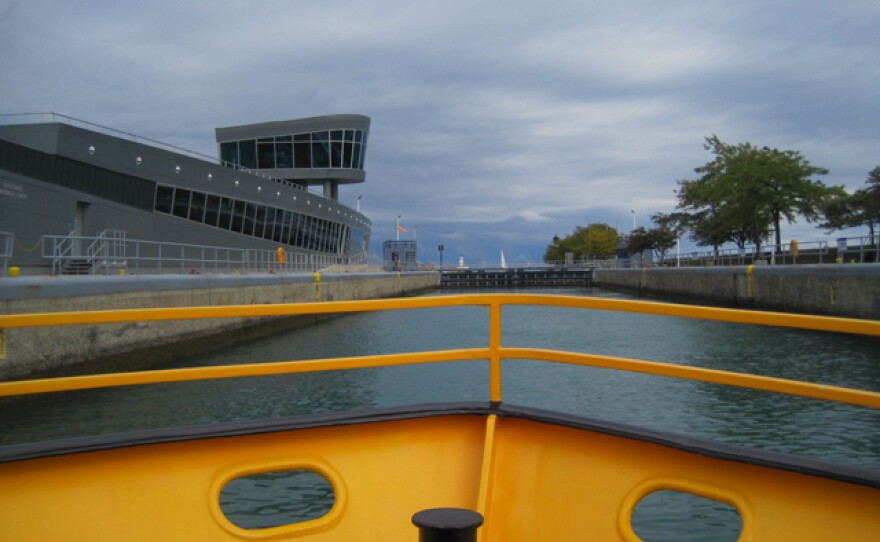The issue of keeping Asian carp out of the Great Lakes has implications for a variety of industries. Midwest officials are weighing a range of options, including severing the connection between the Mississippi River and Great Lakes basins. In the second part of our series on Asian carp, Adam Allington examines the potential economic implications for keeping the carp out of the lakes now, and in the future:
It’s a scorching hot day in East St. Louis, Illinois. Down by the Mississippi River a tugboat is pushing a flotilla of six light green barges. This 70-mile stretch of river is one of the busiest inland ports in America—a place where grain, aggregate and steel are loaded and shipped up and down the river.
“We operate about 200 barges in all parts of the inland waterways, anything that’s connected to the Mississippi.”
Mark Fletcher runs Ceres Barge Lines. At any point roughly a quarter of his business is tied up moving freight in and around the Chicago area. As far as he’s concerned, any carp mitigation strategy that closes or slows shipping on the Chicago canals would be a disaster for his business.
“It would affect us terrifically and it affects the whole industry terrifically because you’ve got so much tonnage that does move up the Illinois River trying to get into the steel mills of Burns Harbor, Indiana, Indiana Harbor, south of Chicago.”
In addition to impacts on manufacturing and shipping, Fletcher says one barge can hold the equivalent of 60 semi-trucks or 40 rail cars.
Mark Biel is the Director of the Chemical Industry Council of Illinois. He says closing the Chicago canals would add roughly a half million more trucks to roads and freeways, posing a real threat to the environment.
“Particularly when it comes to some of the petroleum products and chemical products, the safest way to move those products is to move them by barge. In many cases you don’t want to put them on rail cars or put them on trucks and then move them through neighborhoods. The preferable way to move this product safely is to move it through the barge.”
But severing the physical connection of the Great Lakes to the Illinois and Mississippi rivers isn’t necessarily an “either-or” scenario for industry.
Tim Eder is the Director of the Great Lakes Commission. The best solution, he says, would make it impossible for Asian carp to move upriver but would also provide a workaround for cargo.
“It would be a physical structure in the water, it would be a land bridge made out of concrete and earth. It would include a terminal, where barge traffic would meet on either side of the barrier. There could be superfast unloading elevators and cranes that moved goods from one side of the barrier to the other.”
The Army Corps of Engineers is set to deliver a progress report to Congress in mid-October, including a ballpark cost for basin separation.
Michigan Senator Debbie Stabenow says anything less than basin separation is a non-starter, but she’s also confident that a workable solution in within reach.
“We have, in fact, a $7 billion fishing industry and a $16 billion boating industry in the Great Lakes. But we know that there are other important commercial interests and we need to make sure we find a solution that works for both.”
Still, no matter what the Army Corps recommends, some say the issue of carp getting into the lakes may ultimately have nothing to do with infrastructure.
Michael Borgstrom is the President of Wendella Sightseeing, which has had boats on the Chicago River for over 75 years.
“I just don’t know where the urgency is. I mean, they’re all over the country so… there’s other ways for them to get into the lakes as well.”
Borgstrom thinks the true threat of carp getting into the lakes won’t hinge on barriers, but rather the very real possibility of humans simply taking live carp and dropping them in the lake.
-Adam Allington for The Environment Report
Tomorrow, we’ll hear about ways carp could get into the Great Lakes besides the Chicago shipping canals.








